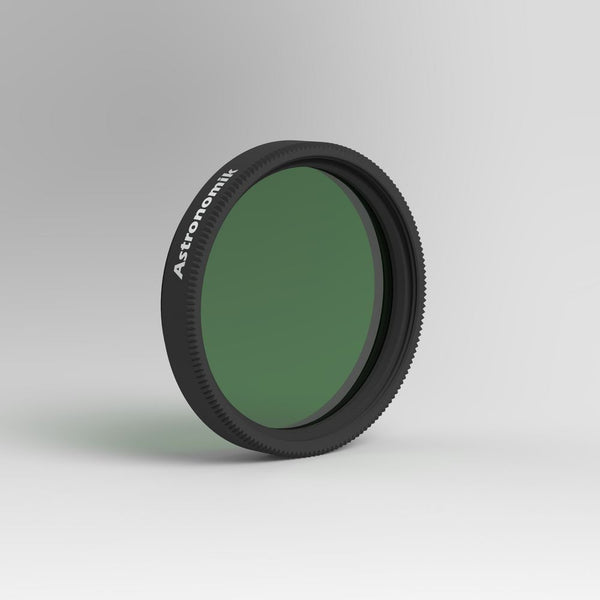Astronomik 1.25"/2" Narrowband Emission Line OIII-CCD Filters w/ 12nm FWHM & MFR Coating (ASK-OIII-12NM-CCD)




Astronomik 1.25"/2" Narrowband Emission Line OIII-CCD Filters w/ 12nm FWHM & MFR Coating (ASK-OIII-12NM-CCD)
Diameter - 1.25" (-125)
Why Purchase from All-Star Telescope?
Free Expert Support
Whether you are a first timer needing help with setting up or an enthusiast that can't quite make that one thing work, our expert staff are ready to support your needs. With decades of knowledge and first hand experience we've been there and we can help you through it!
Stress Free, Secure Transactions
You can trust purchasing and delivery with All-Star Telescope. All of our transactions are 100% secure and Level 1 PCI DSS compliant thanks to Shopify's ShopPay platform. For additional protection, we insure 100% of the value of every shipment we make. If it get's lost during shipment, we replace it. If it gets damaged during shipment, we replace it. We make sure your product arrives exactly as you would expect it to; we promise.
We also ensure privacy protection. We never keep any of your credit card information on file and any of your personal data is stored according to our policies.
30 Day Return Policy
Buy with confidence knowing that we accept returns up to 30 days after purchase. We want you to have something you will actually use and we are confident that we keep good quality products in our store with No Junk.
Price Match Promise
Shipping around for the best price is tough, we make it easier by offering the best pricing in the market. But if you find a better price on an in-store item somewhere else we will match it!
Product Description
Due to the combination of the narrow bandwidth of 12nm and the high transmission of typically 96% the filter gives you an contrast boost, as all unwanted light from other wavelengths than 501nm is blocked form UV up to the IR. This results in an very dark background compared with any filters with a higher bandwidth.
The FWHM of 12nm is optimized for typical DSLR cameras with CMOS sensors and CCD cameras with a normal/high dark current: With these cameras the background signal in images taken from heavily light polluted sites is dominated by the dark current of the sensor, not by fully coming from light pollution. In this case a further reduction of FWHM does not improve the image, as the background will not get darker. Compared to the 6nm filters you have more stars in the field of view which gives you more guiding stars when working with an integrated/dual guiding chip!
Note: Due to the new MFR coating technique you may use one single filter on all instruments up to f/3 without a significant reduction in performance.
Astronomik Tips & Imaging Help
Imaging with Narrowband Emission Line Filters
If you have to observe from light polluted sites (like most of us...), imaging with Narrowband-Emission Line filters is the best way to take great images, as all kind of light pollution can be blocked very effective! Normally an H-alpha filter should be your first step into this amazing field of astrophotography! With an Narrowband H-alpha filter you will be able to take deep and contrasty images even with very heavy light pollution or with the full moon high up in the sky!
If you look at other astrophotos, an H-alpha is the best choice for all nebulas glowing red! An OIII filters expands your imaging possibilities, as you are able to image all greenish/blueish structures. Planetary nebulas and star forming regions are great targets! The SII filters completes your HSO-set of filters. With these three filters you are able to process your images like the ones from the Hubble space telescope!
The h-beta filter is not available in a 6nm version, as this filter has nearly no meaningful application. To illustrate this, there are two images shown below: Both were taken with a unmodified Canon 650D. Even as the camera has a sensitivity of less than 10% at H-alpha, there is some signal und structure in the h-alpha image, while you cannot see anything on the image taken with an H-beta filter!
Operation of the Filter
The filter blocks all unwanted light from artificial light-pollution, natural airglow and moonlight. Especially light from High- and Low-Pressure Sodium and mercury lights and all lines of natural airglow are 100% blocked. The filter increases the contrast between the sky-background and objects glowing at the SII line at 672nm.
Tips and Hints for More Applications
Using the SII filter together with OIII-CCD and H-alpha-CCD filters you make produce false-color emission line images (HSO) in the same way as the Hubble-Space telescope. This is possible even from heavily light polluted sites.
Alternatives
If want to image faint objects in star-crowded regions of the Milky Way, probably using short focal lengths, the 6nm filter will be the better choice, as the number of stars is reduced by a factor of ~2. You should even take the 6nm version if you have a camera with a low thermal current or if you have to observe from a really heavily light polluted site.
Specifications
- Guaranteed Transmission of more than 90% at the OIII Line (501 nm)
- Typical Transmission of 95% at the OIII Line (501 nm)
- Full-Width-Half Maximum (FWHM): 12nm
- Perfect blocking of unwanted light from UV up to the IR
- Parfocal with all Astronomik filters
- MFR Coating technique: Usable with all optics up to f/3
- Thickness of 1mm
- Not sensitive to moisture, scratch resistant, not aging
- Optically polished substrate, striate-free and free of residual stresses
- High quality storage box


